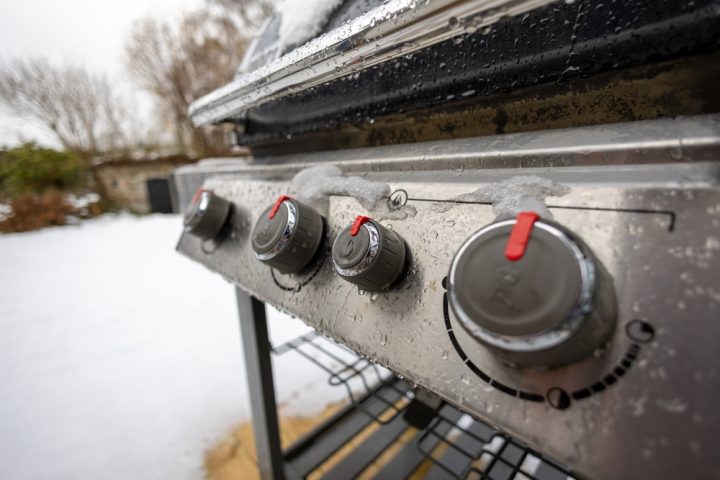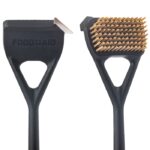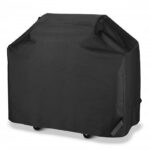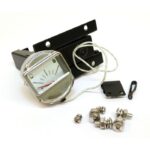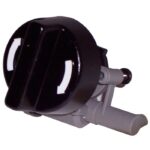The winter can be a difficult season for any grill to weather, even if your barbecue is tucked away and safely stored. Properly winterizing your grill can go a long way to preventing common post-winter grilling problems, but even with deep cleaning and safe storage, you may still face some issues when you pull your gas grill out of storage come spring.
Thankfully, many of these issues can be fixed easily and without much trouble, and they rarely mean you have to replace your entire grill.
In this post, we’ll identify some of the most common gas grill issues grillers may face after winter and share our advice for troubleshooting a gas grill, including:
- Gas grills that won’t ignite
- Grills with no gas flow
- Gas grills with low heat or low flame
- Grills with uneven heat
- Rusty grills and grill parts
- Excessive flare-ups
Let’s jump in.
Problem 1: My gas grill won’t light
If you can light your grill with a match or lighter but your usual push-button igniter isn’t working, good news—gas is still flowing, and chances are you are simply facing a minor issue with your igniter. Here are some of the most common reasons why a gas grill won’t ignite:
- Your igniter battery is dead. Not all igniters are battery-powered, but if yours is, the first thing to do is check and replace the battery. If the battery was dead, you should be good to go after popping in a fresh one. Before you tuck your grill away next winter, be sure to take the battery out to reduce the risk of corrosion and extend the life of the battery.
- The electrodes are dirty or corroded. If a dead battery is not the issue, check the electrodes that connect the igniter button to the spark generator for dirt or corrosion. To clean the electrodes, all you need to do is gently rub a cotton swab dipped in rubbing alcohol over the metal tip of the electrode, let it dry, and try to start the grill. It may take a few tries to get your grill going. If the electrodes are corroded, you can lightly sand off the corrosion and try again.
- The electrodes or wire connections are loose. The placement of the electrodes and wire connections is crucial for sparking the burner. Start by ensuring the gas is off, then check the connections to see if they are in good shape and that the metal tips are intact with no cracks or breaks. Check for frayed wires as well—inclement weather can cause them to fray, and rodents may also chew them up over the winter. If all looks good, disconnect and reconnect the electrodes and wires and try to light your grill again.
If you’ve replaced the batteries in the spark generator, cleaned the electrodes, and none of the wires or electrodes are corroded, frayed, or oxidized, but your grill still won’t ignite, the next step is to replace your igniter. Don’t worry—replacement parts are easy to purchase and often it only takes a few minutes to install them. Read our guide for how to replace a gas grill igniter.
Problem 2: Gas is not flowing to the grill burners
If your grill igniter is clicking or snapping but your grill still won’t light, it’s time to check your gas flow.
Start by confirming there’s actually gas in the tank. You wouldn’t be the first person to store a barbecue with an empty tank! And if you grill in colder weather, you may run out of propane faster than you expect because your barbecue will use more fuel to maintain the same level of heat. You can weigh your propane tank to determine how full it is—a full 20 lb tank will weigh around 37-38 lbs, while an empty one is about 18 lbs. You can also invest in a fuel indicator to keep a close eye on propane levels all season long.
If there’s gas in the tank, the next step is to check for gas leaks. Gas leaks can be caused by a loose connection or a damaged gas hose. It only takes a few moments—here’s how to check for a gas leak.
GRILL SPOT TIP: We recommend always checking for gas leaks at the start of every season, and once more throughout the season, as well as after long periods of storage or non-use.
If there are no gas leaks, it’s time to check for blocked venturi tubes. Pests and rodents can take up residence in your grill’s burners over the winter—spiders are especially fond of these tubes and are a common source of the blockage. To check for and clear blockages, clean the grill burner tubes using a venturi brush or flexible burner cleaning brush. Read our guide to cleaning blocked burner tubes for detailed instructions.
Problem 3: My grill isn’t getting hot enough or has a low flame
Fixing problems with low temperature or low flame is often a simple matter of resetting your grill’s propane regulator.
All gas grills made since the mid-1990s are equipped with a safety device called an “overfill protection device” (OPD) that controls the flow of gas from the propane tank to the burners. The OPD prevents the grill from being overfilled with gas, and it’s easy to inadvertently activate if you turn the control knobs on before you open the propane tank valve. When activated, your grill will go into “bypass mode” and will only ever reach around 250-300 degrees, even with the burners set to the highest setting.
If your grill isn’t getting hot enough, start by trying to reset your regulator. Before you do this, turn off the tank valve and disconnect the propane tank from the grill. If your grill was on, make sure it’s completely cooled before disconnecting the tank, and give it five minutes so the gas can dissipate before you troubleshoot. Then follow these steps:
- Open the grill lid, turn off the gas at the propane tank, and disconnect the gas line from the tank.
- Turn all the control knobs up to high, including your side burner if you have one.
- Wait for one full minute, then turn all the control knobs off.
- Reconnect the gas line to the propane tank and slowly turn the gas on at the tank.
- Light your grill. It should light up and heat properly
Get more advice on how to diagnose and fix gas grill temperature problems.
Problem 4: Uneven heat
When your burners are working properly, you’ll see a flame that is uniform in shape and blue with yellow tips, running along the entire length of the burner. If there are areas of the burner(s) that don’t have flames at all, you may have clogged burner ports. Clogged burner port holes can easily be cleaned out by brushing over the affected area with a bristle brush to loosen debris. If need be, you can also clean out individual port holes using a paperclip or similar item.
If you have high heat but you’re seeing irregularly shaped yellow or orange flames, or the heat is uneven, your burner tubes may not be aligned properly or may be obstructed by insects or other debris.
In the case of severe blockages, the control knobs may also feel hot to the touch, or flames may appear at the front of the grill. If you notice any of these signs, turn your grill off and let it cool. Then remove the cooking grates so you can inspect the burners and burner tubes and clear away any obstructions using a bottle brush or venturi brush. If this doesn’t work, give your grill a good deep clean (especially if you missed this step before storing your grill away for winter).
If your grill is still heating unevenly, follow these steps to check the connections:
- Locate the venturi tube adjustment screw you’ll use to release the shutters in step 3.
- Light the grill and turn it to low.
- Loosen the screw and open the shutters till the flame is mostly blue.
- Turn off the gas and tighten the adjustment screw.
- Let your grill cool.
Problem 5: Rusty grill parts
If you left your grill uncovered or out in the snow all winter, moisture may have seeped in, causing the cooking grates, grill parts, or grill exterior to rust.
Surface rust can often be scraped away using steel wool or other abrasive materials like a wire brush or grill grate scrubber, but deep rust cannot be cleaned. If your cooking grates or interior grill parts are rusting and it doesn’t clean away easily, you can often replace the rusty part. Check out our grill part replacement guides to learn more:
GRILL SPOT TIP: You can prevent rust by spraying cleaned grates with cooking oil to block moisture and cleaning and polishing the grill exterior before storing your barbecue for the winter, and covering your grill with a weather-resistant grill cover.
Many grill parts can be replaced with ease, but if your grill’s exterior is rusting, it may be time to replace your grill—and invest in a properly-fitting, weather-resistant grill cover for your new barbecue.
Problem 6: Excessive flare-ups
Flare-ups are usually caused by grease build-up. If you didn’t do a deep clean before storing your grill for winter, now is the time to do it, especially if you’re experiencing regular or large flare-ups. Give the grill grates and heat plates a thorough clean. Here’s how to clean your grill grates.
Get Grilling
The best way to prevent post-winter gas grill issues is to properly winterize your grill before storing it away for the winter. If you pull your grill out this spring to discover that it won’t ignite, there’s no gas flow, the heat or flame is low or uneven, or you spot rusty parts or experience lots of flareups, don’t panic—most of the time these issues can be fixed in a few minutes with a bit of elbow grease or a simple part replacement.
Get more advice for troubleshooting gas grill problems and when to replace parts:

